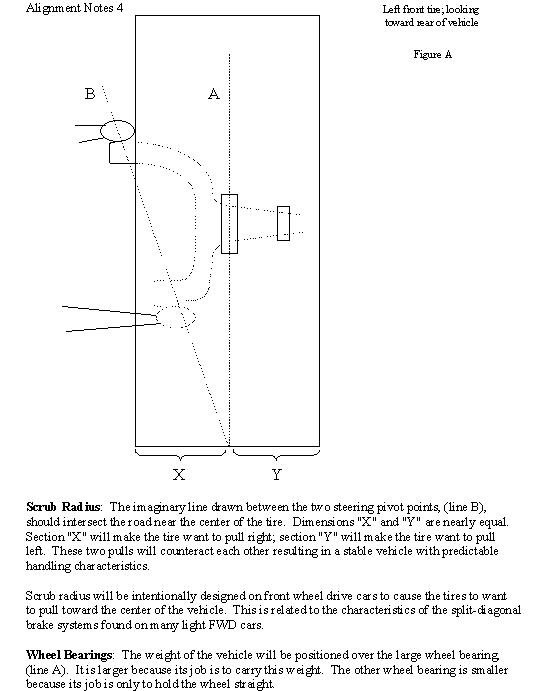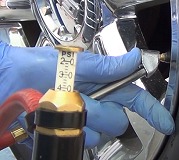If the car has anti-lock brakes, absolutely not. The outer circumference of all four tires must be the same. The computer checks for that as you're driving. If it sees a wheel rotating faster or slower than the others, it knows it won't be able to calculate how it needs to modulate the brake for a locking wheel. In response, it shuts the system down, sets a related diagnostic fault code, and turns on the yellow "ABS" warning light to tell you. Now you're driving without one of the car's safety systems. This can come back to bite you if you're in a crash with injuries. Your insurance premiums are based on the safety systems your car came with. We all know there's a good chance the crash would still have occurred if the ABS system was working, but insurance adjusters don't always see it that way. People even drive cars with deployed air bags cut away, then they expect the insurance company to cover their injuries that might have been avoided.
There are other ramifications of using the wrong size tires. The least of these is larger rear tires will raise the back of the car up a little. That will reduce "caster", one of the three main alignment angles. That angle is primarily involved with the steering wheel returning to center on its own after cornering, without you having to pull it back by hand, and it is responsible for reducing steering wander at highway speeds. Raising the rear of the car an inch is not going to change caster significantly, but it is worth mentioning because if the other guy runs a red light and crashes into you, his lawyer or insurance investigator will find this and use it against you.
The bigger concern in the front has to do with a carefully-designed secondary alignment angle called "scrub radius". My drawing shows the imaginary line drawn through the two steering pivots for one wheel. For your car, that's the lower ball joint and the upper strut mount. In my drawing, it is shown as the lower and upper ball joints. That line is designed to intersect the road surface, in this case, right in the middle of the tire tread.
The inner half of the tread wants to pull toward the center of the car, and the outer half wants to pull away from the center of the car. Those two forces balance each other out so the tire tries to roll straight ahead. Most front-wheel-drive cars use a split-diagonal brake hydraulic system so if there's a leak / failure in one half, you will still always have one working front brake. On older rear-wheel-drive cars, with one front brake disabled on purpose, applying the brakes would tear the steering wheel out of your hands much too hard to hold onto. The same thing would happen with a failure with a split-diagonal system, except scrub radius has been modified to offset that pull. With half the system failed on a Chrysler product, the only way you'd know is the red warning light turns on. On most other brands, at most you'll see a very tiny wiggle in the steering wheel when the brakes are applied. Most people don't even notice a problem except, again, the red warning light turns on.
When you alter the outside dimension of the front tire, you're changing where the imaginary line "B" intersects the road surface, and that changes the ratio between tread sections "X" and "Y". "X" is already a lot larger on front-wheel-drive cars to offset that brake pull, but all the rest of the geometric shape of the suspension system is built around that to produce a stable car with good "predictability". That means you know exactly where the car is going to go when you hit a bump or turn the steering wheel. There are other things we can unintentionally do to GM front-wheel-drive cars to destroy the predictability that aren't possible with other car brands. Adding tire size as another variable will contribute to that and can make for a very miserable car to drive.
Even if you don't mind driving the car with all the design factors compromised, mechanics are always worried about that other guy. Altered ride height, as in raised trucks and lowered cars, and any other modification that adversely affects handling, steering response, and braking distances are what lawyers and insurance investigators love to find, ... On the other guy's car. When their client ran the red light and caused the crash, they will argue that you were partly at fault because you were less able to avoid the crash, and they will be right. If a mechanic was involved with any of those modifications, his shop becomes party to that lawsuit too. That's why you won't find them doing these alterations, and most will only mount the wrong size tire if you take the wheels and tires to the shop off the car. When buying new tires, a conscientious mechanic who has your best interest at heart will check the door sticker to be sure he is selling you the correct size tire or one of the approved optional sizes.
Be aware there are multiple things that affect scrub radius. Wheels with a deeper offset, meaning they sit further out from the car, different diameters, different widths, and on cars with struts, altered ride height all change scrub radius. It is possible to find a tire that's wider, but maintains the desired scrub radius. The tire salesman will know many different sizes that can be used, but the manufacturer also takes rubbing when turning into account for each different car model. The tire salesmen usually don't know which optional sizes will work on a specific car model other than from previous experience, unless it's listed on the door sticker.
Also be aware we are always concerned with suspension ride height. All shops have a small book that lists every car model and year, where to take those measurements, and what they should be. Your car is probably too new to have sagged springs, but when that happens, a wider tire might cause a rub, even if it is listed as an acceptable optional size.
Image (Click to make bigger)
Saturday, April 6th, 2019 AT 4:34 PM



